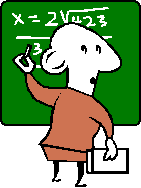

| |
Math 125 Intermediate Algebra
Terry Foley
Office: Math Department
(323) 265-8886
E-mail: Terry@TerryFoley.com
Math 125
Time: 12:45 3:15 T/Th
Room: E5 108
|

|
Textbook:
Elementary & Intermediate Algebra by C. P. McKeague
Prerequisite: Satisfactory completion of Math 115.
Course Description:
This course strengthens and further develops manipulative
skills in elementary algebra. The topics include:
q
Fundamental operations on algebraic expressions
q
Solutions of equations and inequalities
q
Exponentiation
q
Graphs of algebraic, exponential and logarithmic functions
q
Systems of equations and inequalities, and
q
Introduction
to conic sections
Applications are included in a wide variety of worded problems.
Grade:
Your grade will be determined by the following:
|
|
|
Quizzes/Tests
40%
Homework
35%
Final Exam
15%
Attendance
10%
|
|
Homework: Homework
will be assigned at the end of each class and will be due at our next
meeting. Itll be virtually impossible to learn
the material in this class without doing the homework!!
Attendance:
It is important that you attend all classes.
|
|
Some
Definitions - in no special order
Algebra that branch of math that deals with relations and
properties of numbers by means of letters, signs of operations and other
symbols. It includes the solution of equations, polynomials, etc.
Postulate to assume or claim as true - an axiomatic statement.
Axiom an established rule or principle or self-evident truth. Axioms define the
fundamental rules orlaws of mathematics.
Rule - a method for performing a mathematical operation and
obtaining a certain result.
e.g. Cramer's Rule.
Law - law is synonymous with rule.
e.g. Law of Sines.
Theorem - a formula, proposition, or statement in
mathematics or logic deduced from other formulas or propositions.
e.g. the binomial theorem, which comes from the
binomial formula.
Natural numbers they are counting numbers, e.g. 1, 2, 3,
etc.
Whole numbers they are natural numbers, plus zero, e.g. 0,
1, 2, 3, etc.
Integers they include the whole numbers plus the negative
numbers,
e.g. -2, -1, 0, 1, 2, 3, etc.
Real numbers they are all the integers including rational
and irrational numbers
Rational numbers integers that can be represented as
fractions,
e.g.Ύ.
Irrational numbers they cannot be represented as a fraction
and they are non-repeating numbers such as pi, e.g. 3.141592654
..
Complex numbers - any number that can be written as a +
bi, where a represents the real part and bi represents the
imaginary part. i is equal to the square root of -1.
Imaginary numbers - they are represented by the letter i,
where i is equal to the square root of -1.
Prime numbers - any positive integer larger than 1 that is
only divisible by itself and 1. e.g. 2, 3, 5, 7, 11, etc.
Composite numbers - any whole number larger than 1 that is
not a prime number.
Mixed numbers - the sum of an integer and a fraction. e.g.
5Ύ
Polynomial a polynomial is the sum of terms. Terms
are connected by plus and minus signs.
Monomial - a monomial is a single term, e.g. 3x, -4, 15xy.
Binomial - a binomial contains two terms, e.g. a + b.
Quadratics an equation that contains the unknown, x,
to the second (and no higher!) degree.
The standard form of the quadratic equation is:
ax² + bx + c = 0.
This equation is, by definition, a polynomial.
|
|


